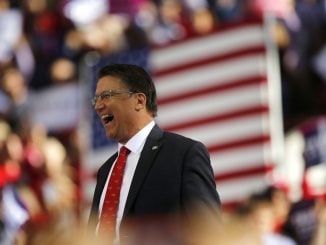
RALEIGH — The growing importance of North Carolina to both Electoral College math and the balance of the U.S. Senate, complemented by fierce battles being waged for leadership of the state, has led to the saturation of the Old North State’s airwaves by the incessant campaign ads.
In a poll conducted by the Civitas Institute asking voters to sum up the election in two to three words, voters were not shy about their distaste for the contest and the professionally produced bickering associated with it.
A Republican Yadkin County woman, voting a straight Republican ticket, said the campaigns are “too negative,” while another Republican man in Durham County said “there is too much mudslinging.”
Unfortunately, there’s a lot more mud to sling yet, according to the numbers.GovernorIncumbent Republican Gov. Pat McCrory and his challenger, Democratic Attorney General Roy Cooper, will have raised tens of millions of dollars between them by Election Day, saving most of their respective war chests for the ad blitz during the final weeks.
The most recent ad-tracking data from the Center for Public Integrity shows as of Oct. 24 more than $32 million has been spent on more than 66,000 ads in the close gubernatorial race when combined with outside spending figures, making it the third-most-expensive race for governor in the nation. McCrory’s incumbency has not translated to a fundraising advantage, though, as reflected in the lopsided spending figures.
Cooper has aired close to 22,000 ads at a price of more than $10 million, nearly doubling McCrory’s approximately 11,000 ads costing just under $6 million. The biggest outside spenders so far have been the Republican Governors Association ($2.6 million), and Democrat PAC, A Better NC ($1.6 million.)The ads have focused on H.B. 2 backlash, problems at the state crime lab, tax and spending issues, as well as the economy.
U.S. Senate
The 2016 race for U.S. Senate between incumbent Republican Richard Burr and Democratic challenger, former head of the N.C. ACLU, Deborah Ross, could be a key race in the current minority’s goal of flipping control of the Senate. According to polls, the race is too close to call, despite the initial funding advantage enjoyed by Burr.
Too close to call is too close for comfort for outside Republican groups seeking to protect Burr’s seat, sparking a late-inning ad blitz that makes this one of the most expensive Senate campaigns in the country. The National Republican Senatorial Committee is now placing $2 million in ads for the embattled incumbent after the Senate Leadership Fund pledged $8 million in ad buys last month to match the millions in spending on behalf of Ross by environmental and labor groups. Thus far Ross has significantly outspent Burr, $7 million to $4.4 million, leaving Burr with more in the tank for the final stretch.
Ross’ controversial stances on sex offender registration as head of the ACLU, and Burr’s extended tenure as an establishment politician dominate the ad messaging.
State Races
Seeking to step into the role of attorney general, state senators Buck Newton (R-Wilson) and Josh Stein (D-Wake) have aired more than 7,000 ads costing nearly $3.5 million so far. Newton’s campaign is being outspent nearly 10-to-1 by Stein’s, but outside contributions help close the gap, like Carolinians For Freedom’s more than $1 million in spending.
Some entities, however, are pulling funding from the close race, such as the Republican Attorney Generals Association rescinding a $3.5 million ad pledge in support of Newton.
Newton has been cast in ads as an architect of the controversial H.B. 2 and as lacking experience for the job, while Stein is described in ads as a hard-left protege of Cooper and John Edwards, a former U.S. senator and candidate for vice president.
Spending in state House and Senate races reveal threatened incumbencies among the Republican super-majority. The campaign of Rep. Nelson Dollar (R-Wake), a major budget writer, has spent nearly $200,000 defending his seat. All told, approximately $3 million in ads have been bought in the N.C. General Assembly elections.
President
While overall campaign spending is down compared to 2012, North Carolina wouldn’t know it. More than $1 billion has been raised by candidates Donald Trump and Hillary Clinton, and billions more being put to work by super PACs have been focused among a core group of swing states, of which North Carolina is the main focus.
The campaigns have spent millions in ads per week across the country, with Trump ($14.4 million) eclipsing Clinton ($13.9 million) in ad spending for the first time last week according to Bloomberg. The Trump campaign has recently increased spending by $300,000 in North Carolina, nearly matching that from the Clinton campaign.
The campaigns are now averaging more than $75,000 in ads a week in North Carolina.
Despite running below 2012 levels, perhaps due to Trump’s unconventional campaign, the candidates and their surrogates are certainly spending more time in North Carolina. Combined they will have racked up dozens of visits from Asheville to Kenansville by Election Day, with both Clinton and Trump having multiple events in the state in the weeks and months since their respective nominations.
Voters may be nearing exhaustion with the ad inundation, but some respondents to the aforementioned Civitas poll think it matches the importance of the election. Still, others like one female Buncombe County Republican lament, “I just wish it was over.”



